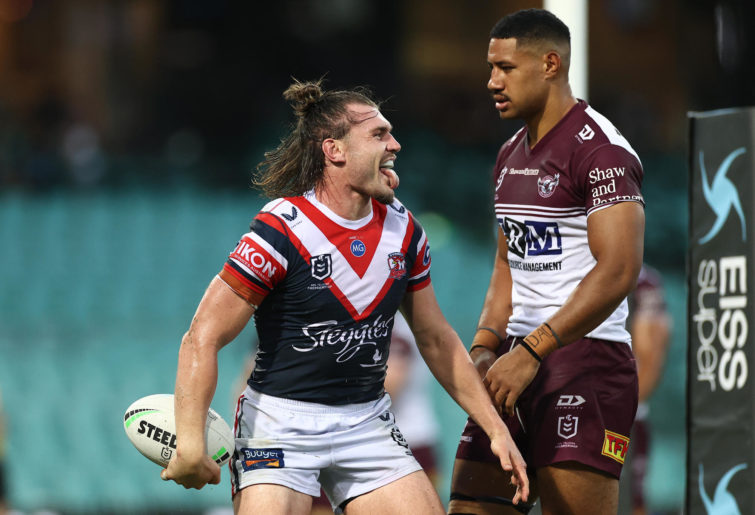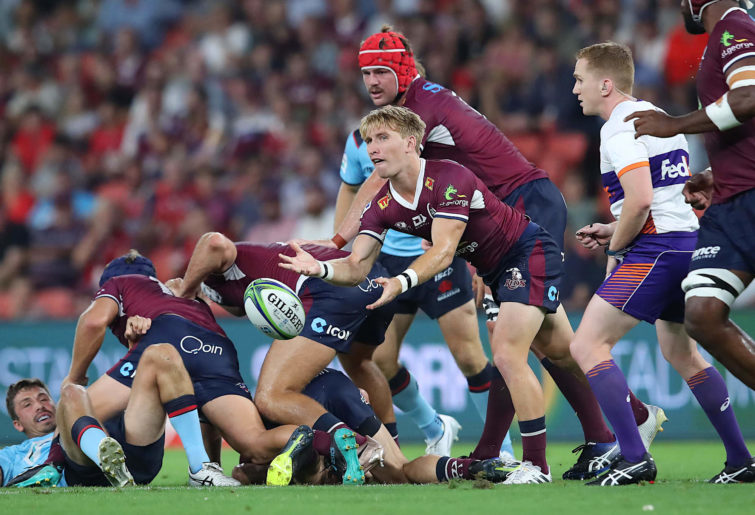Get in your DeLorean, hot tub or a phone box. It’s time to go back in time to 1995 and rugby union is about to turn professional.
For years there has been the unspoken truth that some players were being paid boot money. All of that is about to be consigned to history and rugby union across the globe is to become an open game, where the best players (and some of the lucky) can commit to the sport on a full-time basis and earn a living while pushing the limits of the sport’s boundaries.
There’s a scrabble by the southern hemisphere unions to sign up their best players or best potential players that will put those countries in a strong position for the turn of the century. The Australian Rugby Union, along with its friends in New Zealand and South Africa, have a look at how they are going to shape the game.
Super Rugby is born.
The ARU, with some clarity, identifies that it has two potential sustainable markets: Queensland and New South Wales, the rugby union lifeblood. And this works pretty well for a while. Both teams are competitive against their SANZAAR counterparts, but there is a growing clamour for a third team to be introduced, and there happens to be a pretty handy group playing out of the ACT. As such, the ACT Brumbies are introduced and they hit the ground at a gallop.
Things are rosy in the Australian rugby garden. The Super Rugby teams are competitive, money is coming in for the 2003 World Cup and the Wallabies are fighting it out to be known as the best team in the world.
Then things start to change. Much like the Garden of Eden, darkness starts to encroach and what was once a bright and sunny future becomes more changeable and eventually dark.
Solutions are sought to help re-energise rugby in Australia and help sustain the sport’s foothold in the public psyche. Expansion out to Western Australia to give the game a more national footprint sees the creation of the Western Force, and later down the line the great sporting market of Melbourne and the state of Victoria is hit with the introduction of the Rebels.
Unfortunately, at the same time as this, there is an ongoing exodus of players to Europe and Japan, mismanagement of funding from the ARU (now Rugby Australia) and a disconnect between grassroots, schoolboy rugby and the professional game resulting in an ever-increasing number of once-promising future Wallabies signing contracts with NRL clubs and committing their futures to becoming Kangaroos.

(Photo by Cameron Spencer/Getty Images)
A more in-depth look at this has been covered well by The Australian and The Gold Digger podcast series, both of which identify key opportunities where lessons could and should have been learnt.
So going back to the introduction of professionalism in rugby union. Knowing what we know now, would you do anything different?
When explaining to my other half the landscape of professional rugby in Australia, her response was: “why is there only one team in each area?” Given her lack of interest, bordering on distain, for rugby, or in fact professional sport, this really got me thinking.
Given the recent news that the Penrith Emus are to be removed from the Shute Shield and the ongoing outcry for Rugby Australia to grow the game outside of the traditional areas, if rugby union was to start again, how would I implement professional rugby in Australia?
Being a Pom, I accept that I don’t necessarily have a full understanding or appreciation of the Australian sporting landscape’s intricacies or history.
But given that the global game needs a strong Australia and that rugby union in most countries (New Zealand and France being exceptions) is either fairly niche or the less than ideal business to get in to if you want to make money, my concept for professional rugby in Australia could have worked.
There has been and always will be a rivalry between NSW and Queensland, and then between NSW and Victoria. In fact, NSW, Queensland, Victoria and even ACT all have some form of rivalry.

(Photo by Jono Searle/Getty Images)
There is even now a rivalry between Victoria and Western Australia rugby communities since the expulsion of the Force from Super Rugby, or the retention of the Melbourne Rebels depending on your perspective.
In my new model, rugby union would almost be a combination of the existing Super Rugby AU and the National Rugby Championship (NRC).
The competition would primarily be domestic, meaning that there will always be Australian teams winning each week. If Super Rugby AU taught us anything, it is that winning helps generate interest.
However, the competition also showed that two games a weekend is not enough. On this basis my competition would include the following core teams:
• Sydney
• NSW Country
• Brisbane
• Queensland Country
• ACT Brumbies
• Melbourne Rebels
• Western Force
I would also be keen to get one over the NZRU and include Fiji Drua and either a Moana Pasifika-type team or a Samoan franchise and a Tongan franchise, giving a potential ten-team tournament.
This would mean five games a weekend with some huge derby games such as Country versus City and NSW versus Queensland, plus it would be likely to gain World Rugby backing, and hopefully funding, as it provides potential pathways for Pacific Island players that don’t involve tying themselves to New Zealand or moving across the world to France or the UK.

(Photo by Cameron Spencer/Getty Images)
Now clearly the model is not perfect and there would be an issue with potential strength in depth, but that leads me to my next bit.
Much like the Premier League, NFL and NBA, I would be looking for each team to have third-party ownership, at least in part. This would potentially increase the money available in the game and could lead to greater retention of junior talent and Wallabies talent in Australia and even attract some NRL players who want to play a global sport.
There would be stipulations on the governance of the teams. For example, 80 per cent of match-day squads must be eligible for the country that the team is based, i.e. 80 per cent of Drua players must be eligible to play for Fiji, the same for the Western Force and Australian players. This would lead to at most four or five of a match-day squad being eligible for another nation.
Also, similar to the Irish model, the Australian teams would need to negotiate with Rugby Australia as to which positions these foreign players could primarily play in. This would prevent a situation where all seven Australian teams have New Zealander, English, French or Irish number tens meaning no Aussies get a look in.
I would also include a regulation that any players not involved in match-day squads need to be involved in grassroots clubs, either in a playing, coaching or an admin role. I know it is difficult to enforce, but the idea is that a connection would be grown between the local club game and the professional ranks.

(Photo by Richard Heathcote – World Rugby via Getty Images)
There would be further conditions relating to player development to support post-playing careers, player pathways, coaching standards, minimum and maximum salary caps, minimum facility standards and finally a remit to help grow rugby union participation.
Now, all of this is somewhat fantasy and would be difficult to enforce. But this is my utopian vision and when I come to power, this will be the way it goes.
The final point would be a recognition of those over the Tasman. Unlike the Super Rugby Trans-Tasman competition that happened this year, my tournament would lead to the winner entering into a further competition with the winners of New Zealand and Japanese domestic competitions.
The fourth team in this tournament would be the previous year’s winners. There would then be a draw for semi-finals and an overall final. This would provide a mini Pacific Champions Cup and could be expanded should South Africa rejoin the southern hemisphere club rugby scene and the Super Liga de America Rugby continues to grow, creating a complete southern hemisphere tournament.
Imagine if there was such foresight back in 1995. Imagine where the Wallabies would be now. Probably still losing to New Zealand but at least there would be more rugby!

































































































